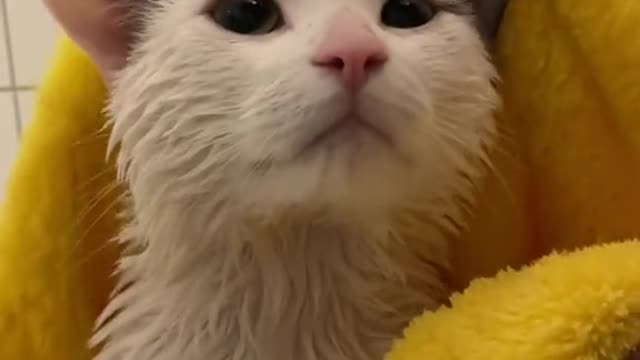Premium Only Content

How to washing your cats and care your cats and dogs
Rumble / Cats & kittens - Cat Grooming Tips
A clean cat is a happy cat, and we're here to help! From nail trims to bathing, a little maintenance goes a long way. Read on to find out how to keep your kitty’s eyes, ears, teeth, skin and fur healthy and clean. Please note: There are some cats who do not tolerate being groomed. If your cat fights the grooming process, and there is some potential that injury could occur to your cat or yourself, please make an appointment with a professional groomer or a veterinarian to have your cat groomed.
Skin and fur care
Bathing Your Cat
With her built-in grooming tools (tongue and teeth), your fastidious feline is well-equipped to tackle her own hair care needs. But if she is very dirty or gets into something sticky or smelly, you may need to give her a bath. Follow these steps to ensure minimal stress and maximum efficiency.
Brushing Your Cat
Brushing your cat not only removes dirt, grease and dead hair from her coat, but it helps to remove skin flakes and stimulates blood circulation, improving the overall condition of her skin. One or two brushings per week will help kitty to keep her healthy glow—and you’ll find that regular sessions are especially beneficial when your cat ages and is no longer able to groom so meticulously on her own.
Before brushing, check out the condition of your kitty’s coat. If it’s healthy, her hair will have a natural gloss and spring back under your hand when you touch it. There shouldn’t be any bald patches or signs of fleas and ticks, and her skin should be free of wounds and unusual bumps.
For short-haired cats: With a metal comb, work the brush through your cat’s fur from head to tail to remove dirt and debris. Work along the lie of her fur, brushing in the direction the coat grows. Brush all over her body, including her chest and abdomen, concentrating on one section at a time to remove dead hair and tangles. A rubber brush can be especially effective for removing dead hair on cats with short fur.
For long-haired cats: Long-haired cats who live indoors shed throughout the year and need grooming sessions every few days to remove dead hair and prevent tangles. Start with her abdomen and legs, gently combing the fur upward toward her head. Comb the neck fur upward, toward her chin. Make a part down the middle of her tail and gently brush out the fur on either side. You can sprinkle talcum powder over knots and gently use your fingers to tease them apart. If the knots don’t come out by hand, try using a mat-splitter.
During your weekly grooming sessions, run your hands along your cat’s body, checking for wounds, bumps and hidden tangles. Check for ticks and flea dirt, black specks of dried blood left behind by fleas. Sneak a peek under her tail to check for feces attached to the fur that may need to be snipped away with scissors. It’s also important to check around your cat’s anus for tan, rice-sized objects—these may indicate the presence of tapeworm.
Neglecting to brush your kitty’s coat can lead to painful tangles and a bellyful of hair. You’ll know if your cat is suffering from hairballs when he coughs them up onto the floor or expels them in his feces. If, despite regular brushing, your cat continues to suffer from hairballs, there are several remedies available. Please ask your vet to recommend a solution.
-
 1:15:25
1:15:25
Glenn Greenwald
5 hours agoTulsi and RFK Jr. Approved by Key Senate Committees; Trump Meets Netanyahu: Wants to Cleanse Gaza; Pro-Palestinian Group Suspended at UMich | SYSTEM UPDATE #402
59K72 -
 LIVE
LIVE
Danny Polishchuk
5 hours agoThe Funniest Call In Show On Earth - Live From New York City's Best Comedy Club
411 watching -
 DVR
DVR
megimu32
5 hours agoON THE SUBJECT: Will the Super Bowl Be WOKE??!
5.63K2 -
 1:18:26
1:18:26
Redacted News
6 hours agoBREAKING! USAID Created and Funded COVID-19 Virus and Bioweapons, RFK and Tulsi pass major hurdle
127K187 -
 50:54
50:54
Candace Show Podcast
6 hours agoBecoming Brigitte: Gaslighting The Public | Ep 1
178K185 -
 4:41:05
4:41:05
Right Side Broadcasting Network
11 hours agoLIVE: President Trump Holds Press Conference with Israeli PM Benjamin Netanyahu - 2/4/25
210K99 -
 1:11:49
1:11:49
Edge of Wonder
6 hours agoInception Is Real: How Ads Are Showing Up in Our Dreams
27.5K5 -
 54:50
54:50
LFA TV
10 hours agoThe Trade War Ends | TRUMPET DAILY 2.4.25 7pm
26K7 -
 2:05:37
2:05:37
Quite Frankly
10 hours ago"Capitol Hill Headlines & The Utah Case" ft Lauren Conlin, The Zells 2/4/25
31.8K7 -
 1:33:29
1:33:29
The Big Mig™
16 hours agoKiller of Men To Healer of Men Dr. Joe Bannon
26.6K5